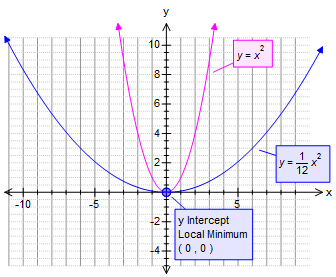Given:|#" " x^2=12y#
Divide both sides by 12 (#-:12 " is the same as "xx1/12#)
#1/12 x^2=12/12xxy#
But #12/12=1# giving
#y=1/12 x^2#
'~~~~~~~~~~~~~~~~~~~~~~~~~~~~~~~
#color(blue)("Let us think about what the numbers are actually doing")#
#color(brown)("Point 1")#
If you had #y=x^2# the graph would be of the shape type U and would have the y-axis in the middle of the curve. Thus the axis of symmetry for that case is the y-axis
#color(brown)("Point 2")#
So what is the #1/12# doing? It is a modifies the graph of #y=x^2#
It is saying: take any value of #x#. Move along the x-axis such that you a looking at #1/12# of the value of #x#. See where on the curve of #y=x^2# the point would be and move that point horizontally to be above the actual value of #x#
So a coefficient (k) of #x^2# such that #0 < k < 1# widens the standard curve of #y=x^2# and any (k) such that #1 < k# narrows the standard curve of #y=x^2#
'~~~~~~~~~~~~~~~~~~~~~~~~~~~~~~~~~~~~~~~~~~~~~~~~~
#color(brown)("Point 3 - Conclusion")#
#y=1/12x^2# is almost the same as #y=x^2# but wider.
They both have the same axis of symmetry: y-axis
They both have the same minimum: #"min "->(x,y)->(0,0)#
because they both have the basic shape of U
'~~~~~~~~~~~~~~~~~~~~~~~~~~~~~~~~~~~~~~~~~~~~~~
Note that if we had #y=-1/12 x^2# then the graph shape would be of type #nnn# and thus we would have a maximum.



